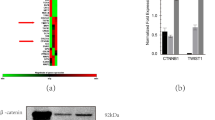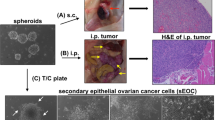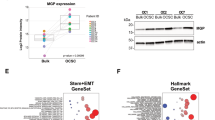Abstract
Epithelial–mesenchymal transition (EMT) is a critical process for embryogenesis but is abnormally activated during cancer metastasis and recurrence. This process enables epithelial cancer cells to acquire mobility and traits associated with stemness. It is unknown whether epithelial stem cells or epithelial cancer stem cells are able to undergo EMT, and what molecular mechanism regulates this process in these specific cell types. We found that epithelial–ovarian cancer stem cells (EOC stem cells) are the source of metastatic progenitor cells through a differentiation process involving EMT and mesenchymal–epithelial transition (MET). We demonstrate both in vivo and in vitro the differentiation of EOC stem cells into mesenchymal spheroid-forming cells (MSFCs) and their capacity to initiate an active carcinomatosis. Furthermore, we demonstrate that human EOC stem cells injected intraperitoneally in mice are able to form ovarian tumors, suggesting that the EOC stem cells have the ability to ‘home’ to the ovaries and establish tumors. Most interestingly, we found that TWIST-1 is constitutively degraded in EOC stem cells, and that the acquisition of TWIST-1 requires additional signals that will trigger the differentiation process. These findings are relevant for understanding the differentiation and metastasis process in EOC stem cells.
This is a preview of subscription content, access via your institution
Access options
Subscribe to this journal
Receive 50 print issues and online access
$259.00 per year
only $5.18 per issue
Buy this article
- Purchase on Springer Link
- Instant access to full article PDF
Prices may be subject to local taxes which are calculated during checkout





Similar content being viewed by others
References
Alison MR, Murphy G, Leedham S . Stem cells and cancer: a deadly mix. Cell Tissue Res 2008; 331: 109–124.
Vergara D, Merlot B, Lucot JP, Collinet P, Vinatier D, Fournier I et al. Epithelial-mesenchymal transition in ovarian cancer. Cancer Lett 2010; 291: 59–66.
Espey DK, Wu XC, Swan J, Wiggins C, Jim MA, Ward E et al. Annual report to the nation on the status of cancer, 1975–2004, featuring cancer in American Indians and Alaska Natives. Cancer 2007; 110: 2119–2152.
Jemal A, Bray F, Center MM, Ferlay J, Ward E, Forman D . Global cancer statistics. CA Cancer J Clin 2011; 61: 69–90.
Mutch D . Surgical manegement of ovarian cancer. Semin Oncol 2002; 29: 3–8.
Cannistra SA, Bast Jr RC, Berek JS, Bookman MA, Crum CP, DePriest PD et al. Progress in the management of gynecologic cancer: consensus summary statement. J Clin Oncol 2003; 21 (Suppl 10): 129–132.
Schwartz PE . Current diagnosis and treatment modalities for ovarian cancer. Cancer Treat Res 2002; 107: 99–118.
Agarwal R, Kaye SB . Ovarian cancer: strategies for overcoming resistance to chemotherapy. Nat Rev Cancer 2003; 3: 502–516.
Clarke-Pearson DL . Clinical practice. Screening for ovarian cancer. N Engl J Med 2009; 361: 170–177.
Fang D, Nguyen TK, Leishear K, Finko R, Kulp AN, Hotz S et al. A tumorigenic subpopulation with stem cell properties in melanomas. Cancer Res 2005; 65: 9328–9337.
Chambers JT, Schwartz PE . Treatment of persistent or recurrent ovarian carcinoma with sequential methotrexate and 5-fluorouracil. Gynecol Oncol 1986; 23: 346–349.
Yang M, Mailhot G, Birnbaum MJ, MacKay CA, Mason-Savas A, Odgren PR . Expression of and role for ovarian cancer G-protein-coupled receptor 1 (OGR1) during osteoclastogenesis. J Biol Chem 2006; 281: 23598–23605.
Radisky DC, Przybylo JA . Matrix metalloproteinase-induced fibrosis and malignancy in breast and lung. Proc Am Thorac Soc 2008; 5: 316–322.
Thiery JP, Sleeman JP . Complex networks orchestrate epithelial-mesenchymal transitions. Nat Rev Mol Cell Biol 2006; 7: 131–142.
Mani SA, Guo W, Liao MJ, Eaton EN, Ayyanan A, Zhou AY et al. The epithelial-mesenchymal transition generates cells with properties of stem cells. Cell 2008; 133: 704–715.
Thiery JP . Epithelial-mesenchymal transitions in development and pathologies. Curr Opin Cell Biol 2003; 15: 740–746.
Chaffer CL, Dopheide B, Savagner P, Thompson EW, Williams ED . Aberrant fibroblast growth factor receptor signaling in bladder and other cancers. Differentiation 2007; 75: 831–842.
Clarke MF, Dick JE, Dirks PB, Eaves CJ, Jamieson CH, Jones DL et al. Cancer stem cells—perspectives on current status and future directions: AACR workshop on cancer stem cells. Cancer Res 2006; 66: 9339–9344.
Radisky DC, LaBarge MA . Epithelial-mesenchymal transition and the stem cell phenotype. Cell Stem Cell 2008; 2: 511–512.
Hollier BG, Evans K, Mani SA . The epithelial-to-mesenchymal transition and cancer stem cells: a coalition against cancer therapies. J Mammary Gland Biol Neoplasia 2009; 14: 29–43.
Alvero AB, Chen R, Fu HH, Montagna M, Schwartz PE, Rutherford T et al. Molecular phenotyping of human ovarian cancer stem cells unravels the mechanisms for repair and chemoresistance. Cell Cycle 2009; 8: 158–166.
Steffensen KD, Alvero AB, Yang Y, Waldstrom M, Hui P, Holmberg JC et al. Prevalence of epithelial ovarian cancer stem cells correlates with recurrence in early-stage ovarian cancer. J Oncol 2011; 2011: 620523.
Gao Q, Geng L, Kvalheim G, Gaudernack G, Suo Z . Identification of cancer stem-like side population cells in ovarian cancer cell line OVCAR-3. Ultrastruct Pathol (Res Supp, Non-US Gov’t) 2009; 33: 175–181.
Bapat SA, Mali AM, Koppikar CB, Kurrey NK . Stem and progenitor-like cells contribute to the aggressive behavior of human epithelial ovarian cancer. Cancer Res 2005; 65: 3025–3029.
Moserle L, Indraccolo S, Ghisi M, Frasson C, Fortunato E, Canevari S et al. The side population of ovarian cancer cells is a primary target of IFN-alpha antitumor effects. Cancer Res (Res Supp, Non-US Gov’t) 2008; 68: 5658–5668.
Szotek PP, Pieretti-Vanmarcke R, Masiakos PT, Dinulescu DM, Connolly D, Foster R et al. Ovarian cancer side population defines cells with stem cell-like characteristics and Mullerian Inhibiting Substance responsiveness. Proc Natl Acad Sci USA (Res Supp, N.I.H., Extramural Res Supp, Non-US Gov’t) 2006; 103: 11154–11159.
Curley MD, Garrett LA, Schorge JO, Foster R, Rueda BR . Evidence for cancer stem cells contributing to the pathogenesis of ovarian cancer. Front Biosci (Res Supp, N.I.H., Extramural Res Supp, Non-US Gov’t Review) 2011; 16: 368–392.
Curley MD, Therrien VA, Cummings CL, Sergent PA, Koulouris CR, Friel AM et al. CD133 expression defines a tumor initiating cell population in primary human ovarian cancer. Stem Cells 2009; 27: 2875–2883.
Zhang S, Balch C, Chan MW, Lai HC, Matei D, Schilder JM et al. Identification and characterization of ovarian cancer-initiating cells from primary human tumors. Cancer Res 2008; 68: 4311–4320.
Chen R, Alvero AB, Silasi DA, Mor G . Inflammation, cancer and chemoresistance: taking advantage of the toll-like receptor signaling pathway. Am J Reprod Immunol 2007; 57: 93–107.
Chen R, Alvero AB, Silasi DA, Kelly MG, Fest S, Visintin I et al. Regulation of IKKbeta by miR-199a affects NF-kappaB activity in ovarian cancer cells. Oncogene 2008; 27: 4712–4723.
Mor G, Yin G, Chefetz I, Yang Y, Alvero A . Ovarian cancer stem cells and inflammation. Cancer Biol Ther 2011; 11: 708–713.
Alvero AB, Fu HH, Holmberg J, Visintin I, Mor L, Marquina CC et al. Stem-like ovarian cancer cells can serve as tumor vascular progenitors. Stem Cells 2009; 27: 2405–2413.
Sharabi AB, Aldrich M, Sosic D, Olson EN, Friedman AD, Lee SH et al. Twist-2 controls myeloid lineage development and function. PLoS Biol 2008; 6: e316.
Watanabe O, Imamura H, Shimizu T, Kinoshita J, Okabe T, Hirano A et al. Expression of twist and wnt in human breast cancer. Anticancer Res 2004; 24: 3851–3856.
Yang J, Mani SA, Donaher JL, Ramaswamy S, Itzykson RA, Come C et al. Twist, a master regulator of morphogenesis, plays an essential role in tumor metastasis. Cell 2004; 117: 927–939.
Cheng GZ, Zhang WZ, Sun M, Wang Q, Coppola D, Mansour M et al. Twist is transcriptionally induced by activation of STAT3 and mediates STAT3 oncogenic function. J Biol Chem 2008; 283: 14665–14673.
Gort EH, van Haaften G, Verlaan I, Groot AJ, Plasterk RH, Shvarts A et al. The TWIST1 oncogene is a direct target of hypoxia-inducible factor-2alpha. Oncogene (Res Supp, Non-US Gov’t) 2008; 27: 1501–1510.
Alvero AB, Montagna MK, Holmberg JC, Craveiro V, Brown D, Mor G . Targeting the mitochondria activates two independent cell death pathways in ovarian cancer stem cells. Mol Cancer Ther 2011; 10: 1385–1393.
Chefetz I, Holmberg JC, Alvero AB, Visintin I, Mor G . Inhibition of Aurora-A kinase induces cell cycle arrest in epithelial ovarian cancer stem cells by affecting NFkB pathway. Cell Cycle 2011; 10: 2206–2214.
Mor G, Yin G, Chefetz I, Yang Y, Alvero A . Ovarian cancer stem cells and inflammation. Cancer Biol Ther 2011; 11: 708–713.
Zeisberg M, Neilson EG . Biomarkers for epithelial-mesenchymal transitions. J Clin Invest 2009; 119: 1429–1437.
Alix-Panabieres C, Vendrell JP, Slijper M, Pelle O, Barbotte E, Mercier G et al. Full-length cytokeratin-19 is released by human tumor cells: a potential role in metastatic progression of breast cancer. Breast Cancer Res 2009; 11: R39.
Carambula SF, Matikainen T, Lynch MP, Flavell RA, Goncalves PB, Tilly JL et al. Caspase-3 is a pivotal mediator of apoptosis during regression of the ovarian corpus luteum. Endocrinology 2002; 143: 1495–1501.
Hader C, Marlier A, Cantley L . Mesenchymal-epithelial transition in epithelial response to injury: the role of Foxc2. Oncogene 2010; 29: 1031–1040.
Bechtel W, Zeisberg M . Twist: a new link from hypoxia to fibrosis. Kidney Int 2009; 75: 1255–1256.
Horbinski C, Mojesky C, Kyprianou N . Live free or die: tales of homeless (cells) in cancer. Am J Pathol 2010; 177: 1044–1052.
Lee YB, Bantounas I, Lee DY, Phylactou L, Caldwell MA, Uney JB . Twist-1 regulates the miR-199a/214 cluster during development. Nucleic Acids Res 2009; 37: 123–128.
Laursen KB, Mielke E, Iannaccone P, Fuchtbauer EM . Mechanism of transcriptional activation by the proto-oncogene Twist1. J Biol Chem 2007; 282: 34623–34633.
Comijn J, Berx G, Vermassen P, Verschueren K, van Grunsven L, Bruyneel E et al. The two-handed E box binding zinc finger protein SIP1 downregulates E-cadherin and induces invasion. Mol Cell 2001; 7: 1267–1278.
Hartwell KA, Muir B, Reinhardt F, Carpenter AE, Sgroi DC, Weinberg RA . The Spemann organizer gene, Goosecoid, promotes tumor metastasis. Proc Natl Acad Sci USA 2006; 103: 18969–18974.
Hay ED . The mesenchymal cell, its role in the embryo, and the remarkable signaling mechanisms that create it. Dev Dyn 2005; 233: 706–720.
Valsesia-Wittmann S, Magdeleine M, Dupasquier S, Garin E, Jallas AC, Combaret V et al. Oncogenic cooperation between H-Twist and N-Myc overrides failsafe programs in cancer cells. Cancer Cell 2004; 6: 625–630.
Entz-Werle N, Stoetzel C, Berard-Marec P, Kalifa C, Brugiere L, Pacquement H et al. Frequent genomic abnormalities at TWIST in human pediatric osteosarcomas. Int J Cancer 2005; 117: 349–355.
El Ghouzzi V, Legeai-Mallet L, Aresta S, Benoist C, Munnich A, de Gunzburg J et al. Saethre-Chotzen mutations cause TWIST protein degradation or impaired nuclear location. Hum Mol Genet 2000; 9: 813–819.
Shintani Y, Maeda M, Chaika N, Johnson KR, Wheelock MJ . Collagen I promotes epithelial-to-mesenchymal transition in lung cancer cells via transforming growth factor-beta signaling. Am J Respir Cell Mol Biol 2008; 38: 95–104.
Blanpain C, Horsley V, Fuchs E . Epithelial stem cells: turning over new leaves. Cell 2007; 128: 445–458.
Kurman RJ, Shih Ie M . The origin and pathogenesis of epithelial ovarian cancer: a proposed unifying theory. Am J Surg Pathol 2010; 34: 433–443.
Shih Ie M, Chen L, Wang CC, Gu J, Davidson B, Cope L et al. Distinct DNA methylation profiles in ovarian serous neoplasms and their implications in ovarian carcinogenesis. Am J Obstet Gynecol 2010; 203: 584, e1–22.
Kamsteeg M, Rutherford T, Sapi E, Hanczaruk B, Shahabi S, Flick M et al. Phenoxodiol—an isoflavone analog—induces apoptosis in chemoresistant ovarian cancer cells. Oncogene 2003; 22: 2611–2620.
Abrahams V, Straszewski S, Kamsteeg M, Hanczaruk B, Schwartz P, Rutherford T et al. Epithelial ovarian cancer secrete funcitonal Fas ligand. Cancer Res 2003; 63: 5573–5581.
Green JM, Alvero AB, Kohen F, Mor G . 7-(O)-Carboxymethyl daidzein conjugated to N-t-Boc-hexylenediamine: a novel compound capable of inducing cell death in epithelial ovarian cancer stem cells. Cancer Biol Ther 2009; 8: 1747–1753.
Koga K, Cardenas I, Aldo P, Abrahams VM, Peng B, Fill S et al. Activation of TLR3 in the trophoblast is associated with preterm delivery. Am J Reprod Immunol 2009; 61: 196–212.
Visintin I, Feng Z, Longton G, Ward DC, Alvero AB, Lai Y et al. Diagnostic markers for early detection of ovarian cancer. Clin Cancer Res 2008; 14: 1065–1072.
Schmittgen TD, Livak KJ . Analyzing real-time PCR data by the comparative C(T) method. Nat Protoc 2008; 3: 1101–1108.
Acknowledgements
This study was supported in part by grants from NCI/NIH RO1CA127913, RO1CA118678, The Janet Burros Memorial Foundation, The Sands Family Foundation and the Discovery To Cure Research Program. GY was supported by the Brozman Foundation. Special thanks to Dr Ernst-Martin Fuchtbauer for the plasmids, pEMSV, pEMSV-TWIST1 and pEMSV-E12; and to Dr Wange Lu for the plasmid pFUIGW.
Author information
Authors and Affiliations
Corresponding author
Ethics declarations
Competing interests
The authors declare no conflict of interest.
Additional information
Supplementary Information accompanies the paper on the Oncogene website
Supplementary information
Rights and permissions
About this article
Cite this article
Yin, G., Alvero, A., Craveiro, V. et al. Constitutive proteasomal degradation of TWIST-1 in epithelial–ovarian cancer stem cells impacts differentiation and metastatic potential. Oncogene 32, 39–49 (2013). https://doi.org/10.1038/onc.2012.33
Received:
Revised:
Accepted:
Published:
Issue Date:
DOI: https://doi.org/10.1038/onc.2012.33
Keywords
This article is cited by
-
TWIST1 induces proteasomal degradation of β-catenin during the differentiation of ovarian cancer stem-like cells
Scientific Reports (2022)
-
CBX7 binds the E-box to inhibit TWIST-1 function and inhibit tumorigenicity and metastatic potential
Oncogene (2020)
-
Sialyl Lewisx-P-selectin cascade mediates tumor–mesothelial adhesion in ascitic fluid shear flow
Nature Communications (2019)
-
Pharmacology and toxicology of the novel investigational agent Cantrixil (TRX-E-002-1)
Cancer Chemotherapy and Pharmacology (2017)
-
Claudin-4 activity in ovarian tumor cell apoptosis resistance and migration
BMC Cancer (2016)



